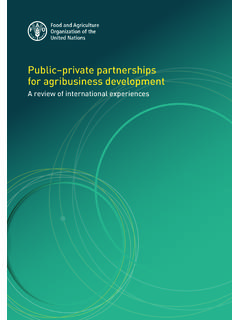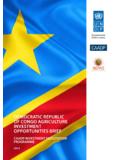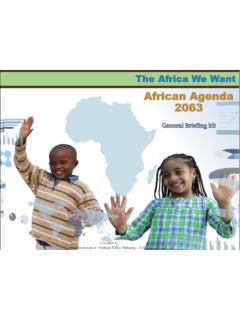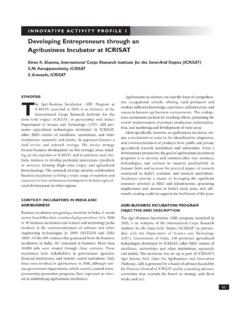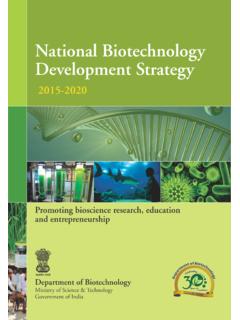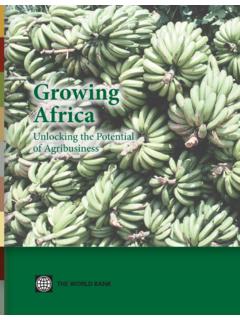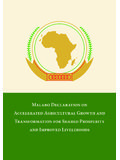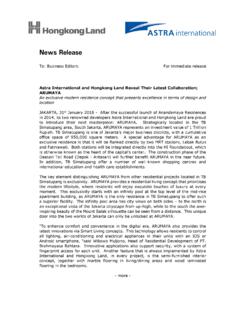Transcription of An Introduction to Collective Marketing by Smallholder …
1 Market Linkages and Value Chains Group An Introduction to Collective Marketing by Smallholder Farmers David Neven, FAO - Market Linkages and Value Chains Group Market Linkages and Value Chains Group Structure of the Session: Background discussion Model 1: The SACRED Model (public-driven) Model 2: The KPMC Model ( private -driven) Plenary discussion Creating opportunities for Smallholder farmers to get in on the action .. Market Linkages and Value Chains Group Market Model 1 Traditional Surplus Sales Collector Collector Model 2 Collective Value Chain Sales Market Marketing Organization Coop/assoc Marketing firm Cereal bank WRS Auctions aggregation storage transport quality stndrds finance/credit accounting Marketing sales/pricing processing Issues: power, scale economies, transaction costs, value creation, competitiveness, exclusion, leverage Successful cooperation among smallholders strong business rationale and relationships with the private sector costs vs.
2 Benefits, there is a profit in it! the demands placed on farmer groups does not exceed their current group management skills and financial capacities delegation to an audited management body may be needed!; right internal cohesion and group dynamics (small size, homogeneity, face-to -face contact , accountability among members) takes time!; supportive legal environment (legal status of the FO). Groups have a role to play but do not provide an easy institutional response to the new pressures facing smallholders in a liberalized economy. Nor should farmer cooperation be viewed as a panacea for the development of rural areas (Stringfellow et al. 1997). Market Linkages and Value Chains Group Examples Large players!
3 Amul 3 million dairy farmers in India Juan Valdez 500,000 coffee farmers in Colombia Examples from Africa Rwanda - Rice coop program Ucorirwa Kenya - Githunguri Dairy Farmers Co-op Society Ethiopia - Oromia Coffee Farmers Coop Union Uganda Farmer group maize sales to P4P/Mukwano FAO training materials developed a number of innovative training approaches and materials for building the capacity of FO s to put in place transparent financial, management and Marketing systems. Market Linkages and Value Chains Group Results from the current survey What Collective activity? Production: 39% Buying inputs: 29% Marketing : 13% Why not act collectively? Don t know who to collaborate with: 29% Difficult to agree as a group: 23% Waste of time: 22% Maize income collaborating farmers: 60% higher Market Linkages and Value Chains Group The Public Role in Collective Action Models Traditional Role ( push ) The donor (or government) drives group formation, and provides most (even 100%) of management, strategy, operational, and Marketing guidance.
4 Subsidies and grants play a big role. The donor operates via a fixed-term project (often not more than 4 years). The donor typically has various objectives, both social and economic. private sector/agribusiness (apart from the farms themselves) has little role in the project beyond input supply and output purchasing. Philosophy: use public resources to show farmers the value of the Collective model and they will adopt it. Alternate Role ( pull ) The donor (or government) has a smaller role primarily as a facilitator between producers and agribusiness, who are jointly in the driving seat. Equity investments play a big role. The donor provides basic services, such as training, on an on-going/permanent basis.
5 Commercial viability is the core joint objective of agribusiness and farmers group. Donor services are provided according to the evolving needs of the farmer-agribusiness relationship and other changes in the staple market. Philosophy: develop the Collective model through farmer, private sector, public sector, civil society partnerships Market Linkages and Value Chains Group Models put forth by Neven, Woolverton and Okello, 2012 Market Linkages and Value Chains Group An Introduction to Collective Marketing by Smallholder Farmers David Neven, FAO - Market Linkages and Value Chains Group










